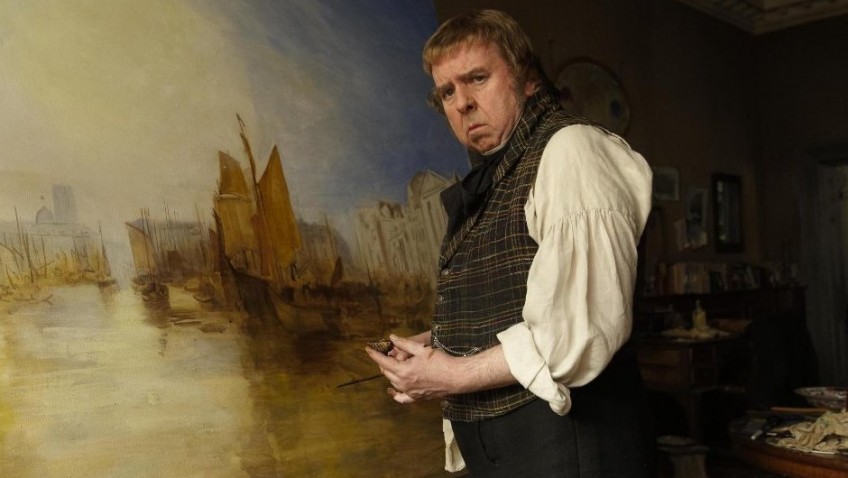Mr Turner (October 31, 2014)
We are fortunate to still live in a country where, in the afternoon we can see a world-class exhibit of JMW Turner’s late paintings at Tate Britain, and, in the evening, catch Mike Leigh’s Mr Turner, a breathtakingly beautiful, meticulously produced biopic about Joseph Mallord William Turner’s late years.
What prompted Leigh to make his first British biopic since Topsy-Turvy fifteen years ago?
Though Leigh tells us that he has wanted to make a film about JMW Turner for years, it might also be that, at 71, Leigh is interested in other artists who produce some of their best and most innovative works of art in their 60s and 70s.
While Mr Turner is certainly one of Mike Leigh’s best films and a major achievement, it is curiously devoid of tension and insights into the man and his late work.
In 1829, at the death of his beloved father (Paul Jesson), a former barber and wig maker, Turner (Timothy Spall) is left alone with his loyal housekeeper, Hannah Danby (a courageous performance from Dorothy Atkinson) whom he sexually exploits, despite her Psoriasis, ill health and obvious affection for him.
Turner’s father used to help him buy his paints and clean his brushes, a task that Hannah willingly undertakes as it brings her closer to her master.
On frequent painting trips to Margate, Turner lodges, under the alias of Mr Mallord, with Sophia Booth (Marion Bailey, wonderful) an earthy, jovial, self-sufficient landlady (in real life, 23 years his junior) with a zest for life.
At the death of her second husband, Mrs Booth and ‘Mr Booth’ (as Turner became known to the locals) live in unmarried bliss on the Chelsea Embankment until his death in 1851. Neither Hannah, nor Sarah Danby (Ruth Sheen) the mother of Turner’s two unacknowledged illegitimate daughters, is told about the house or about Mrs Booth.
Though Turner’s relationship with women is fascinating (he grew up motherless, with his father hardly regretting her death), the film wants to focus on his passion for work. Spall has been well tutored in Turner’s mannerisms, from grunting to spitting on the canvas, to rubbing sand in the paint and using extreme physicality to engage with his canvases.
Spall started learning to paint two years before the start of principal photography so that he would know more than just how to hold a brush and palette. But Spall’s portrayal of Turner, which earned him the Best Actor award at the Cannes Film Festival this year, is not all about painting.
Through Spall, Leigh has no difficulty reminding us that Turner was not an intellectual like Ruskin, but a working class boy who mixed with the aristocracy and rose to become a legend in his lifetime through genius and hard work alone.
One of the best scenes in the film takes place at the Royal Academy on Varnishing Day, when the exhibiting painters put the final touches on their canvases for the Annual Exhibition (still held at the Royal Academy every summer).
Seeing Constable’s (James Fleet) monumental ‘Opening of Waterloo Bridge’, with its touches of festive red across the canvas, Turner rushes over to his amorphous grey seascape, Helvoetsluys, and adds a dot of red to the middle of the painting. The gesture seems so gratuitous that it offends Constable.
Later, Turner returns to transform the red blob into a life-buoy to the amusement of his reverential colleagues. Seeing Helvoetsluys at the Tate exhibit, it is difficult to imagine the painting without this buoy.
There is an interesting, sub-plot about the painter Benjamin Haydon (Martin Savage), a friend of Turner who ran into money trouble, could not provide for his large family and committed suicide at age 60 in 1846.
Haydon turns belligerent over his need for money and disgraces himself, first at Lord Eastlake’s (Robert Portrall) Petworth House and then at the Academy, where the Academicians make his life worse by expelling him.
When Turner hears about the sickness and death in Haydon’s large family, he forgives him his debt. One has to question the relatively significant chunk of time devoted to Haydon, but perhaps Leigh wanted to show a kinder side to Turner.
Or perhaps Turner wants to foreshadow the hostility and ridicule that Turner was to suffer when Academy members and even of Queen Victoria (Sinead Matthews) viewed his more abstract, ‘impressionistic’ works.
British DOP/cameraman Bill Pope competes with Turner’s oils and watercolours with his dazzling widescreen lighting and camerawork. But this is also where we realise that, despite Spall’s convincing performance and the fastidious production and set design – this sumptuous production has 19th century port cities oozing off the screen – Leigh has not solved the problem of how to dramatise this painter’s personal journey and artistic evolution.
Leigh does try to place the milestone paintings in a context, such as the scene at the Royal Academy described above, or another, Slavers Throwing Overboard the Dead and Dying’ (not, sadly, in the Tate show), a controversial commentary on the slave trade that Ruskin purchased.
Leigh creates a scene in which Turner visits the Ruskins’ where an oddly young, but accurately opinionated, Ruskin (Joshua McGuire) turns the conversation to Turner’s ideal, the great 17th century French painter Claude Lorrain, or ‘Claude’.
It’s a pity that this conversation is so brief, as Claude’s influence on Turner cannot be underestimated. The Lorrain/Turner relationship is behind the famous Turner bequest to the National Gallery that is alluded to a later scene when Turner turns down a wealthy collector’s (the manufacturer Joseph Gillot) offer to buy his entire remaining output for an astonishing sum.
Turner simply tells Gillot that he has promised the collection to the nation so his works can be seen together, for free. In fact, the bequest came with a stipulation that two of Turner’s great paintings be displayed alongside two of Claude’s owned by Gallery so that Turner’s association with Claude would last and be acknowledged.
Too often, however, the context of the paintings appears episodic and shallow as do the large number of artists and companions who are never identified let alone characterised. We see Turner wandering about and spotting a high-speed new railway emerging at full throttle out of the haze, followed by a studio scene of his painting of ‘Rain, steam, and Speed.’
In another scene, Turner is in a boat with unidentified men, when what should pass them by but the Fighting Temeraire being hauled into its final resting place. One of the men suggests that Turner paint the scene, which he does of course, creating one of his greatest masterpieces.
If the Tate’s revealing exhibit raises questions about Turner’s relationship with progress (in both the film and exhibit, for instance, we see the nostalgic image of the antiquated Fighting Temeraire being towed by a new steam powered tug), and the quality of his late output, there are no answers in the film; no point of view. There are not even questions. Nowhere do we get sense of how or why the late paintings came about.
Was Turner consciously changing his techniques and colours by choice, by whim, by necessity or all three? Was Turner a forward looking impressionist, or an increasingly sick, old man whose blurry yellow canvases were due to failing eyesight?
Were his paintings impressionistic, or simply unfinished because he could not find a buyer when the taste shifted to the Pre-Raphaelites whom Turner abhorred? Or can the paintings be explained as the product of a man old and rich enough to experiment, to condemn the businesses of slavery and whaling with impunity and to have the luxury of leaving canvases unfinished?
by Joyce Glasser, MT film reviewer




